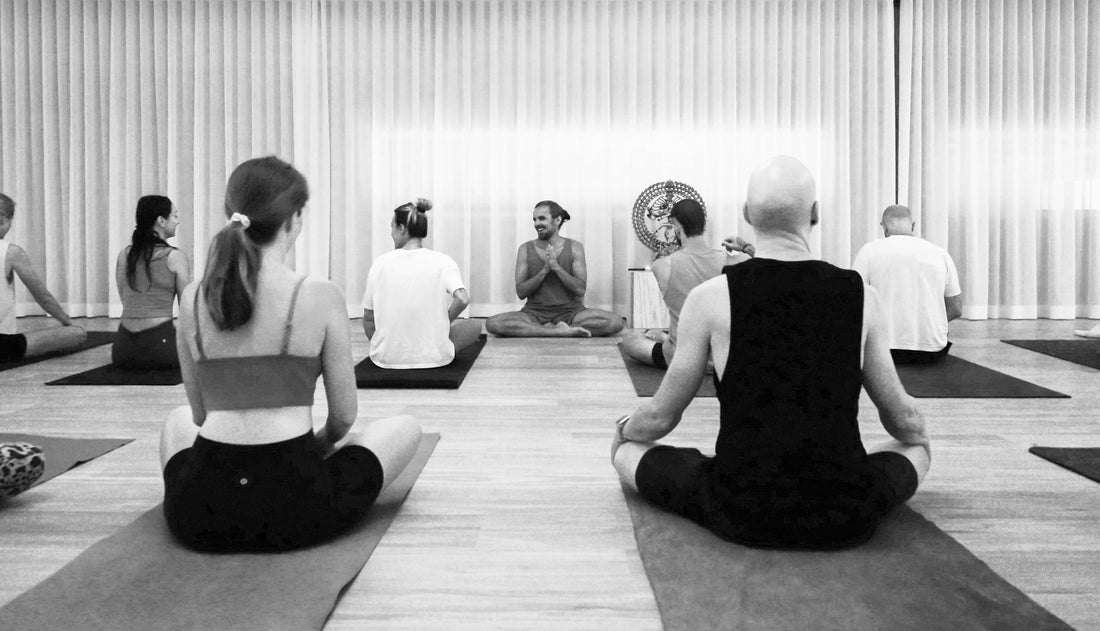Welcome to Yukti Yoga & Ayurveda.
Our new yoga studio upstairs in Belmondos Organic Market. We are excited to offer traditional daily Mysore style Ashtanga yoga classes with a highly respected and experienced teacher, Olivier David.
Come join us on the mat and discover the many benefits of this invigorating practice.
INTRO OFFER: New Student Month Unlimited
ASHTANGA YOGA
Ashtanga yoga is a powerful and dynamic practice that is perfect for both beginners and experienced yoga lovers. One of the key benefits of Ashtanga yoga is its emphasis on consistency and repetition. By practicing the same sequences of postures each day, practitioners develop a deeper understanding of their own bodies and minds. This consistency also allows for a steady progression in strength, flexibility, clarity and focus.Ashtanga yoga is also known for its focus on the breath, which is closely tied to the movement of the body. This helps to create a meditative state, which can reduce stress and improve overall well-being.
Ashtanga Primary Series LED class
Mysore Style Yoga Class
Mysore style Ashtanga yoga is a unique way of practicing the traditional Ashtanga yoga system. In this style, students learn the Ashtanga yoga sequence at their own pace and with individualised attention from the teacher. Each student works through the sequence at their own pace, with the teacher providing adjustments and modifications as needed. This allows for a more personalised and self-directed practice. Mysore style Ashtanga yoga is particularly well-suited for beginners, as it allows for a gradual and comfortable introduction to the practice.

Olivier David is Certified Level 2 Ashtanga Yoga Teacher with over 20 years teaching experience in the traditional Mysore teaching method, as taught to him by his teachers Sri K Pattabhi Jois and R Sharath Jois.
THE EIGHT LIMBS OF YOGA - ASHTĀNGA YOGA
The eight limbs of yoga were originally described in the Yoga Sūtras of Patañjali and have become widely accepted as a framework for yoga practice. These limbs illuminate basic principles of living a meaningful and purposeful life, and indicate morals and ethics that guide yoga practitioners’ conduct, self-inquiry and, ultimately, self-realization. These eight limbs are as relevant today as they have been for millennia. They enable us to deepen our relationships with ourselves and the people around us day-to-day, and moment-to-moment. These guidelines for self-mastery are among the greatest contributions to humankind, passed down from teacher to student since ancient times.
1. YAMA - SELF-CONTROL
Yama refers to five self-control practices that harmonise our relationship with external reality. They are intended to illuminate the quality of our intentions, motivations, choices and actions. Our intentions affect the space between our inner awareness and the living beings and objects outside of us. The intentions we hold help to determine the quality of our experience in the world.
Ahimsā – practicing non-violence and doing no harm.
Satya –honesty in action and speech.
Asteya –refraining from stealing or taking that which has not been freely given.
Brāhmāchārya – Controlling the senses and sensual impulses; engaging in activities with full awareness.
Aparigraha – Refraining from greed and possessiveness.
These yamas are considered as the great universal vows when they are extended unconditionally for the benefit of all, regardless of status, place, time or circumstance. Patañjali Yoga Sūtras. 2:31
2. NIYAMA – SPIRITUAL OBSERVANCES
Niyama are practices that cultivate spiritual insight and states of awareness that confer clarity and truth.
Shaucha: Purity and cleansing of the body, mind, as well as external spaces of activity.
Santosha: Being content and satisfied in the present moment.
Tāpasya: Being disciplined and self-responsible in worldly and spiritual activities.
Swādhyāya: Self-study and contemplation. Observing the thought patterns, past conditioning and behaviors that shape and influence our actions.
Īshwara Pranidhāna: Cultivating faith, trust and surrender, and dedicating one's one’s actions to the greater truth.
From purification of one’s essence, cheerfulness arises, and with it, one-pointed concentration, mastery of senses, and the capacity for sustaining the vision of True Self. From contentment one gains utmost happiness.
Through the intensity of self-discipline and purification comes the dwindling of all impurities and the perfection of the body and senses. From self-study comes communion with one’s personal deity. From devotion to the Omniscient, one is given perfect absorption into Spirit. – Patañjali Yoga Sūtras. 2:46
3. ĀSANA – PHYSICAL POSTURES
Āsana practices help a person develop physical and mental sturdiness and flexibility, clear obstructions, and strengthen the energetic pathways to encourage proper flow of prāna (vital energy). The purpose of this is to prepare a person physically and mentally to sit comfortably in meditation.
Asana is a steady and comfortable position, and is mastered by relaxation and effort, lessening the tendency for restless breathing, and promoting an identification of oneself as living within the infinite breath of life – Patañjali Yoga Sūtras. 2:46-47
4. PRĀNĀYĀMA – REGULATING VITAL ENERGY
Prānāyāma is the art of harmonising the flow of prāna (vital energy) and mastering the mind through breathing techniques. When a practitioner can control and expand their vital energy, they can access deeper and subtler states of consciousness.
When this asana is acquired, prānayama naturally follows, with the cessation of the movements of inspiration and expiration. As a result of this prānayama, the veil obscuring the radiant supreme light of the inner-self dissolves– Patañjali Yoga Sūtras. 2:49,52
5. PRATYĀHĀRA – WITHDRAWAL OF THE SENSES FROM THEIR OBJECTS
As a practitioner attunes their conscious state to the inner fields of experience, there is a natural disengagement and withdrawal of awareness from the sensory pathways, and awareness can then be directed and concentrated inward. This withdrawal of the senses develops through consistent practice of the previous limbs of yoga.
When the energy of the senses withdraws and the impetus to come in contact with their objects ceases, the senses imitate, as it were, the essential nature of pure consciousness. Patañjali Yoga Sūtras. 2:54
6. DHĀRĀNA - CONCENTRATION
Dhārana refers to single-pointed attention or concentration. This is the practice of holding the mind on an internal object or point of awareness.
Dhārana is the confining of thought to one point. – Patañjali Yoga Sūtras. 3:1
7. DHYĀNA – DISSOLUTION OF SUBJECT AND OBJECT
Whereas dhārāna is concentration on a single object, dhyāna is when that focus is maintained for a period of time.
Dhyana depends upon the foundation for directing thoughts into a continuous flow of awareness. – Patañjali Yoga Sūtras. 3:2
8. SAMĀDHI - INTEGRATION
The practices of dhārāna and dhyāna help a person to develop a single-pointed flow of attention. When this attention is maintained for some time, the witness and the object become singular. This union between subject and object leads to a spontaneous dissolution of thought and a flowing state of awareness called samādhi. Samādhi is the re-emergence of non-dualistic awareness. This, according to yoga, leads to self-realization.
Being absorbed in Spirit is that consciousness, whose object is void of form or goal, and only the essence of that object remains shining forth. – Patañjali Yoga Sūtras. 3:3
Excerpt from "Ayurveda- The Knowledge of Life, An introduction to the art of living Ayurveda" By Wayne Celeban (Book release date mid-2023)
See you there!


